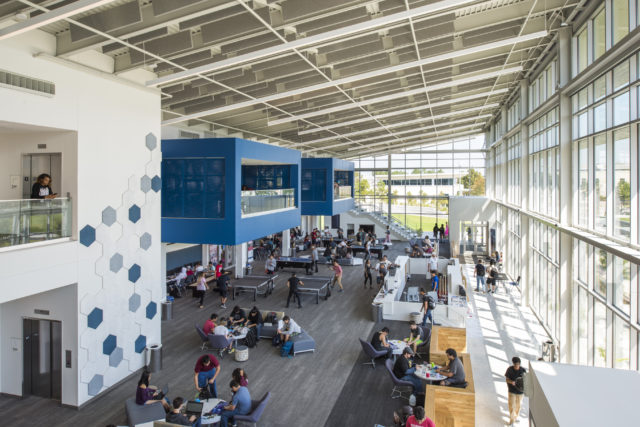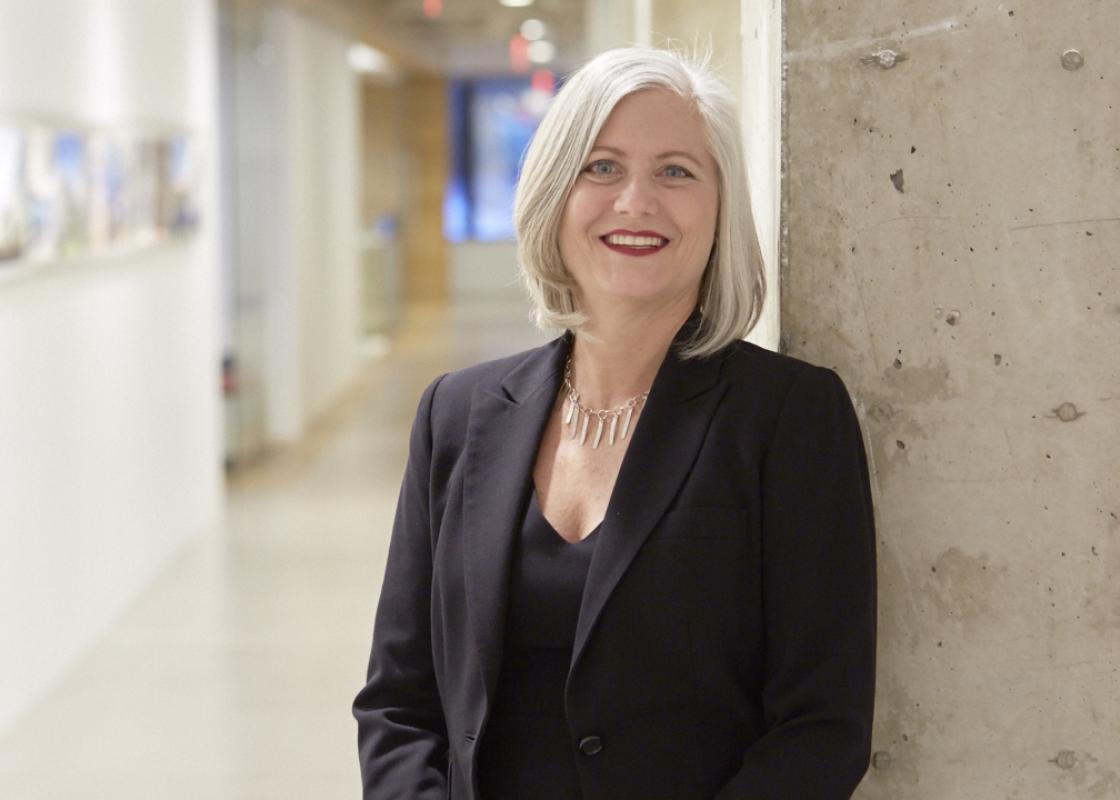Rice Design Alliance is holding its 2018 architecture tour April 7-8 and publishing this series of edited interviews on the theme "Balance: Celebrating Women in Design." In this interview, Cynthia Dehlavi, Research and Design Associate at OJB, talked with Kimberly Hickson, Principal at Gensler and a former board president of the Rice Design Alliance.
As a Community Sector Leader and member of the Practice Area Management Committee for Gensler, Hickson's work includes libraries, labs, housing, and academic facilities. She was elected to the AIA College of Fellows for delivering cost-effective sustainable design through innovative collaboration. She holds a Master of Architecture and Bachelor of Architecture from the University of Kansas and a BFA in Interior Design from Iowa State University.
Cynthia Dehlavi: First, please tell me about yourself.
Kimberly Hickson: I'm from Iowa and I started my education in Computer Science. I was not interested. I went to Iowa State to get my Bachelor in Fine Arts in Interior Design. I had some inspiring professors from California who taught me interior design is really interior architecture and got me really motivated to work with architects.
I got out of school and got married and landed in Kansas City, and lo and behold I could not find a firm that had integrated interior designers with architects. They were somebody separate picking colors and furniture. The only job offer I had was in the library at a global firm. I said no thank you. I did some other things and got on a career path, and went back to architecture school at the University of Kansas while I was in Kansas City. I commuted back and forth. I worked full time and went to school full time. I was in a second degree program. It was two years and three summers. I stayed for an extra year and did my thesis on sustainable design just when Bob Berkebile was starting the green movement after the Hyatt had crashed in the 1980s. My professor said, why would you ever study green architecture, it's just a fad. I tried to study housing for old folks for several months before I went into green architecture and aced my master's thesis. One of my points is to really follow what you are passionate about. Before I graduated I was recruited from one of Bob Berkebile's competitors. They came to the school, and asked if anyone knows anything about sustainability. I spent my first three months researching and then telling every team what to do.
 Lone Star CyFair. Courtesy Gensler.
Lone Star CyFair. Courtesy Gensler.
CD: Who is Bob Berkebile?
KH: Bob Berkebile is the grandfather of green design. He is the B in BNIM. He started the AIA committee on the environment. He started the US Green Building Council. A Kansas City architect, who was also architect of the Hyatt where 112 people perished and that was the most significant architecture disaster until September 11. He pulled bodies out. For two years he couldn't work. When everything settled he knew he had to do something else. That's how he became this green guru.
CD: How did you end up here?
KH: I ended up in Houston by coming down to open an office for BNIM. I ended up at Gensler during the downturn of 2008 and 2009. BNIM shut down its office here. I had the opportunity to reimagine my career. I looked at how many principals were women at firms I interviewed with. That was part of the decision of where I wanted to go.
CD: You looked for firms where there were more women or firms that needed more women?
KH: I looked for firms that were celebrating women. Gensler has a lot of interior folks. I went through the list. Of the peers, they were leading the pack in terms of women at the top.
CD: Who is a mentor of yours? Or who had a big impact on your life?
KH: Bob Berkebile for sure — a great mentor, influencer, absolutely an amazing man who could take a five-minute debrief and go into a meeting and change the whole chemistry. He was a great negotiator and collaborator. He was able to teach me how to change the outcome to what you want. "What do you need?" he would say. I need XYZ. He was able to change the situation.
Madeline "Maddy" Burke-Vigeland has been a huge mentor for me here at Gensler. Early on I got appointed to a firm-wide position. She put me in a firm-wide sector leadership position. I felt a lot of support from a lot of women in this organization. We were firm-wide practice area leaders for the education practice area. She is in New York. I was here and the other co-leader was in Chicago … Our jobs were to motivate everyone else.
CD: Did she show you the ropes?
KH: She was supportive in lots of ways. Not only giving me opportunities, but putting me in a position that allowed others to see my strengths and putting me forward for her job, which was a sector leadership, over eight practice areas. For the last year, I have been on the management committee which helps make firm-wide decisions. She has been very instrumental. This goes back to another thing on my list. No one is going to give you everything. You have to take it. She saw me picking things up immediately without asking. Entrepreneurship is really celebrated here. Her style of mentorship is about putting you into the right place and pushing you forward, helping you navigate. Five thousand people [at Gensler] sounds like a lot but it is really small.
CD: Can you describe a moment when you achieved a dream?
KH: An early one was having the eighteenth LEED Platinum building in the world, leading the team, and taking what was planned to be a Gold building and when construction finished was Platinum. One of my best pieces of advice for anybody is to write your goals down. Have goals. Reevaluate them. When you reach a goal, look back. Yes I did this. I wanted to do this.
CD: In an interview published in 2016, Zaha Hadid said she gravitated to cultural projects because it does not involve the kind of schmoozing needed for corporate projects. I'm curious if you had a similar situation.
KH: Like her, I thrive in the public world, maybe not because of the schmoozing, but more importantly because it is a multi-headed client that is very complicated. One of the things I do well is to read between the lines and understand the true needs. A client who doesn't know how to design anything says they need X but they may need Y. In the public world, you have more of a chance to influence that than you do with a developer who just wants something done. When I had somebody walk off a job and say they couldn't deal with this client, I realized I loved the client type and I don't know what I would do not working with a public client. With Gensler, I have worked mostly with education, and arts and culture clients. It's more about the bigger impact. The spaces actually influence somebody's learning, they influence a community. I know when I was in school, I wanted to be an interior and residential designer, then a commercial designer thinking I'll influence more people. Really, public work, and specifically education, has a huge impact on children, their lives, their success, and their ability to impact the community later on. So I feel like I am able to use our space to wrap our arms around them and make a difference in their lives.
CD: Are there situations in your career when gender was limiting or enabling?
KH: I never felt like gender was limiting. I took the playing field as it is. When I first got out of school, a woman applied for a grant and put together a female lecture series in Kansas City. She made a booklet of all the projects women did at the turn of the century. Many of them worked for free but all this architecture around Kansas City done in the 1900s by women — I thought it was all great, but I never really separated women and men. I have never had a gender issue or barrier.
I don't know if space itself is gendered. Women may bring a sensitivity that our male peers don't have or don't see. In my mind, we think through the details several steps beyond what it looks like on the outside. We think beyond that. Gender could possibly have an opportunity to influence the design.
 Lamar University. Courtesy Gensler.
Lamar University. Courtesy Gensler.
CD: Could you walk into a building and identity if it is female or male designed?
KH: I can feel that in houses for sure. I was just looking at some newly designed houses with my mom. The same for apartments.
CD: In Houston could you say there is a highly masculine or a highly feminine project?
KH: That's a good question. I haven't thought about it a lot yet. I don't think in good design it shows up. Looking at Maya Lin, the Vietnam Memorial competition, her response was quite different than the rest. But I can't really walk around and tell one space from the other.
CD: I can't either!
KH: I was involved in an older women architects group in Houston. We would get together once or twice a year. They would help each other pass the [architecture exams]. Lots of crying. Places for women to gather is very important. I'm supportive of the AIA [Women in Architecture] group to get back together. I think the tide has changed since the 1980s when I got out of school. It is more important today for people to find that support system. I don't know if there are any particular topics that are specific for women compared to men. Pushing people, mentoring, leadership skills are important for both sides of the fence.
CD: I saw Zaha speak once. She cusses a lot. She had a cigarette. She has a harshness. I loved it. She told everyone to eff off. She had an aggression to her which has to do with her becoming a female architectural icon. Women are often taught to be polite, not to be like what I experienced from Zaha. I wonder if we are too polite.
KH: I think we are too afraid to ask for what we want, knowing we should get that promotion, get that raise. We are too timid. That would be helpful for women, whether it is grit, learning those skills, being ok with what might happen. Different environments are different. I had a good friend from here who went to Boston and had a horrible experience with male-dominated firms. I know issues are out there and need to be addressed. I don't believe in segregating ourselves. My belief has always been, this is what I have to play with, and figure out my way to the top.
 Kinder HSPVA. Courtesy Gensler.
Kinder HSPVA. Courtesy Gensler.
CD: It's a good perspective. What are your thoughts on mentorship? What would you give to the next generation of women, or men?
KH: We talked about this in the beginning. Follow your heart, do something you are passionate about. Find something outside your everyday work that gives you that purpose, whether it is low-income housing, sustainability, women's issues, whatever it is, find that passion outside the office and get involved. Get involved in your community. You don't know how it will influence but it will change your career and will be helpful in the long run. Find that passion and do what you love to do. My old professor who said, you won't get a job. He became my biggest fan. Don't be afraid to do what you want to do. People who may be your most challenging roadblocks may become your biggest cheerleaders. Figuring out how to get over, around, or under it is important. As far as mentorship, both ways is important. Find a mentor, be a mentor. Bring somebody along with you. We don't do our job in a vacuum. It is not about I, it is about we. Always bring someone up with you. Make sure it is not just you in the spotlight. Acknowledge it is a team.
CD: Any final thoughts? Anything I didn't ask you?
KH: Obviously client relationships are so big in what we do. We talked about that with public verses private work. You touch so many people with public work. Your emotional intelligence is really important. Taking care of your clients is really important.
CD: I like that motto. Thank you very much.










